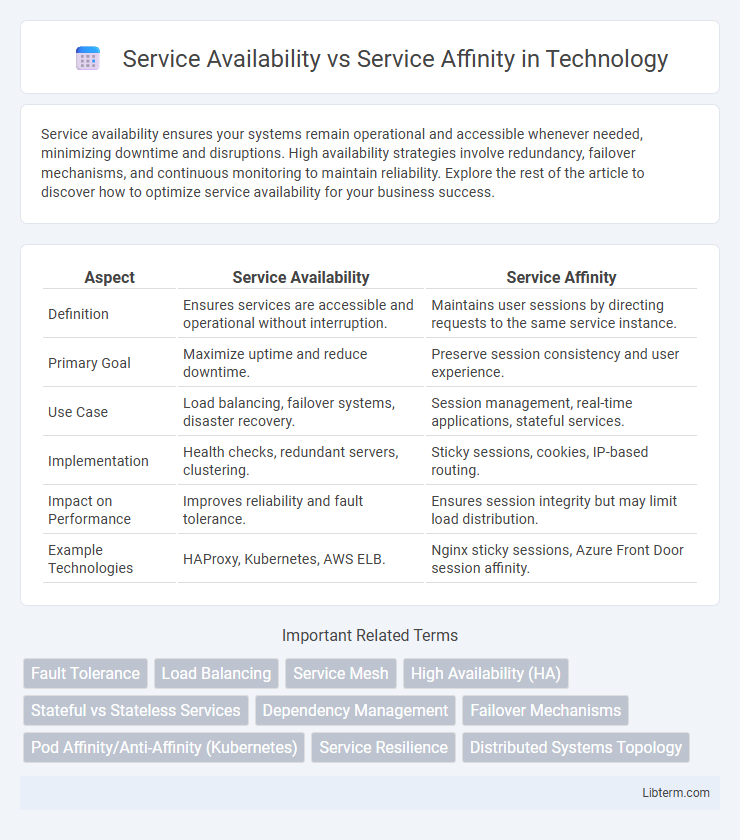Service availability ensures your systems remain operational and accessible whenever needed, minimizing downtime and disruptions. High availability strategies involve redundancy, failover mechanisms, and continuous monitoring to maintain reliability. Explore the rest of the article to discover how to optimize service availability for your business success.
Table of Comparison
| Aspect | Service Availability | Service Affinity |
|---|---|---|
| Definition | Ensures services are accessible and operational without interruption. | Maintains user sessions by directing requests to the same service instance. |
| Primary Goal | Maximize uptime and reduce downtime. | Preserve session consistency and user experience. |
| Use Case | Load balancing, failover systems, disaster recovery. | Session management, real-time applications, stateful services. |
| Implementation | Health checks, redundant servers, clustering. | Sticky sessions, cookies, IP-based routing. |
| Impact on Performance | Improves reliability and fault tolerance. | Ensures session integrity but may limit load distribution. |
| Example Technologies | HAProxy, Kubernetes, AWS ELB. | Nginx sticky sessions, Azure Front Door session affinity. |
Understanding Service Availability
Service availability measures the proportion of time a service remains operational and accessible, often expressed as a percentage like 99.9% uptime, reflecting system reliability and user satisfaction. It is critical in designing IT infrastructures, ensuring minimal downtime through redundancy, failover mechanisms, and proactive monitoring tools. Understanding service availability helps organizations maintain continuous service delivery, reduce revenue loss, and improve customer trust.
Defining Service Affinity
Service affinity refers to the consistent routing of user requests to the same server or service instance to maintain session state and optimize performance. Unlike service availability, which ensures that services remain operational and accessible, service affinity emphasizes user experience by reducing latency and preventing session data loss. Implementing service affinity is critical in distributed systems where maintaining stateful interactions enhances reliability and responsiveness.
Key Differences Between Availability and Affinity
Service availability refers to the percentage of time a service is operational and accessible to users, often measured by uptime metrics such as 99.9% SLA guarantees. Service affinity, on the other hand, relates to the consistent routing of user sessions to the same service instance or server, ensuring session persistence and improved user experience. Key differences include availability focusing on system reliability and uptime, whereas affinity emphasizes session management and statefulness across distributed environments.
Importance of Service Availability in IT
Service availability ensures continuous access to IT resources and applications, minimizing downtime and enhancing user experience. High service availability is critical for maintaining business operations, preventing revenue loss, and supporting compliance requirements in enterprise environments. Effective monitoring and infrastructure redundancy contribute significantly to achieving optimal service availability levels.
Role of Service Affinity in Application Architecture
Service affinity plays a crucial role in application architecture by ensuring that client requests are consistently directed to the same service instance, which optimizes session management and improves performance. This targeted routing minimizes state synchronization overhead and enhances the user experience in stateful applications like online banking or e-commerce platforms. Unlike service availability, which emphasizes redundancy and failover, service affinity focuses on maintaining session continuity and reducing latency by preserving interaction context within a single instance.
Factors Affecting Service Availability
Service availability depends on factors such as system reliability, network robustness, and failover mechanisms, which ensure continuous access to services despite failures. Service affinity influences session persistence by directing user requests to specific servers, but does not inherently guarantee uptime or availability. Infrastructure scalability, error detection, and rapid recovery processes critically impact overall service availability in distributed environments.
How Service Affinity Influences Performance
Service affinity directs user sessions to specific servers, enhancing cache utilization and reducing latency by maintaining consistent resource allocation. This targeted approach minimizes load balancing overhead and improves response times compared to generic service availability strategies. Optimizing service affinity is crucial for applications demanding high throughput and low latency, such as real-time analytics and personalized content delivery.
Balancing Availability and Affinity in System Design
Balancing service availability and service affinity is crucial in distributed system design to ensure both high uptime and optimal user experience. High availability prioritizes system resilience and failover capabilities, while service affinity maintains state consistency by routing users to specific servers. Effective load balancing strategies combine health checks and session persistence techniques to optimize resource utilization without compromising reliability or user session continuity.
Best Practices for Managing Service Availability and Affinity
Service availability best practices include implementing redundant systems, continuous monitoring, and automated failover to ensure minimal downtime and rapid recovery. Managing service affinity requires balancing session persistence techniques, such as sticky sessions or token-based affinity, with load distribution strategies to optimize resource utilization without sacrificing user experience. Integrating dynamic scaling and health checks enhances both availability and affinity by adapting to traffic changes while maintaining consistent session handling.
Future Trends: Evolving Approaches to Availability and Affinity
Service availability is increasingly enhanced through distributed cloud architectures leveraging edge computing to minimize downtime and ensure consistent user access. Service affinity evolves with artificial intelligence-driven workload management systems, dynamically allocating resources to optimize user-specific performance and session persistence. Emerging trends indicate a convergence of availability and affinity strategies, integrating predictive analytics and real-time monitoring for proactive fault management and personalized service delivery.
Service Availability Infographic

 libterm.com
libterm.com